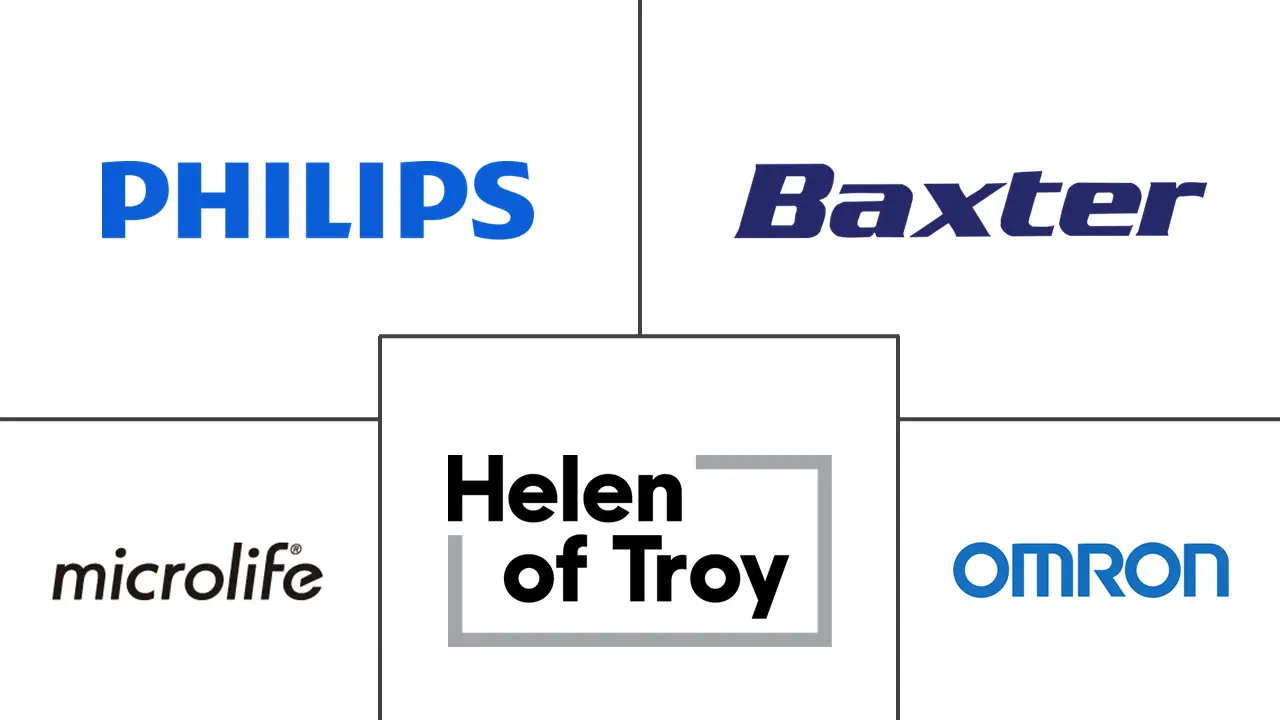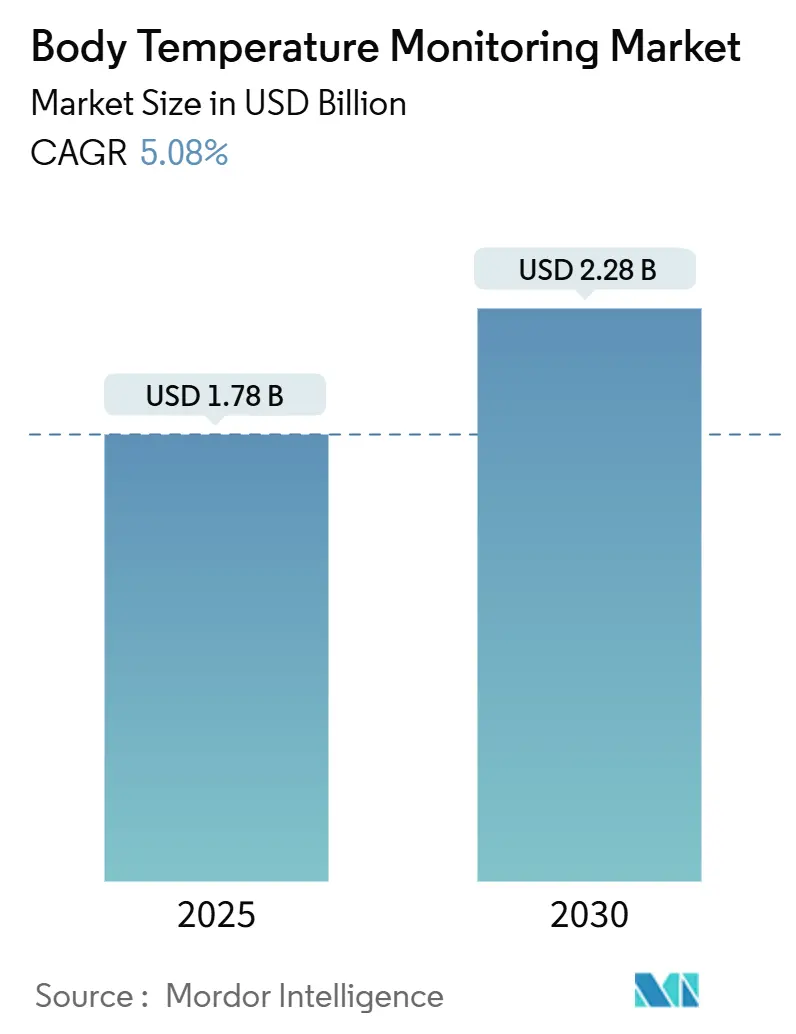
Body Temperature Monitoring Market Analysis by Mordor Intelligence
The body temperature monitoring market size stands at USD 1.78 billion in 2025 and is forecast to reach USD 2.28 billion by 2030, advancing at a 5.08% CAGR. The healthy growth reflects a transformation from episodic thermometry toward always-on, IoT-enabled ecosystems that fuse temperature with hemodynamic and respiratory data. Pandemic-era screening routines, an aging global population, and regulatory incentives that phase out mercury devices all continue to stimulate demand. Contact devices retain clinical trust because of accuracy, but non-contact infrared (IR) systems and wearables expand quickly as hospitals, workplaces, and households embrace hygienic, touch-free workflows. Manufacturers accelerate vertical integration and software partnerships, aiming to bundle sensors, analytics, and cloud dashboards into one platform.
Key Report Takeaways
- By product type, contact devices led with 62.58% of body temperature monitoring market share in 2024, while non-contact IR systems record the highest projected CAGR through 2030.
- By distribution channel, the offline segment held 71.47% of the body temperature monitoring market size in 2024, whereas online platforms are set to post the fastest CAGR to 2030.
- By application, oral cavity measurement captured 35.39% revenue share in 2024; wearable and other emerging sites are projected to grow at the quickest pace over the forecast horizon.
- By end-user, hospitals accounted for 53.62% of demand in 2024, yet home-care environments are expanding at the strongest CAGR to 2030.
- By geography, North America commanded 41.58% of 2024 revenue, while Asia-Pacific is forecast to grow at 5.75% CAGR through 2030.
Global Body Temperature Monitoring Market Trends and Insights
Drivers Impact Analysis
| Driver | (~) % Impact on CAGR Forecast | Geographic Relevance | Impact Timeline |
|---|---|---|---|
| Infectious-disease outbreaks elevate screening demand | +1.2% | Global, higher in APAC and MEA | Short term (≤ 2 years) |
| Digital and wearable sensor innovation lowers ownership cost | +1.1% | North America and EU lead, APAC follows | Medium term (2-4 years) |
| Hygiene-focused shift to non-contact IR thermometers | +0.9% | Global, early adoption in developed markets | Medium term (2-4 years) |
| Expanding pediatric and geriatric cohorts require frequent checks | +0.8% | Global, highest in North America and Europe | Long term (≥ 4 years) |
| Smart-hospital IoT integration of temperature data | +0.7% | North America and EU core, spill-over to APAC | Long term (≥ 4 years) |
| Fertility-tracking wearables using wrist-skin temperature | +0.4% | Global, highest penetration in developed markets | Medium term (2-4 years) |
| Source: Mordor Intelligence | |||
Rising Infectious-Disease Outbreaks Drive Screening Demand
Temperature checks moved from ad-hoc crisis responses to permanent daily routines in hospitals, schools, and corporate campuses. The United States Food and Drug Administration issued performance recommendations for mass thermal screening systems, signaling regulatory acceptance of non-contact public venue deployment. AI-enhanced calibration and sensor fusion—linking thermal images with heart-rate or SpO₂ inputs—now address the false-negative risk exhibited in early pandemic devices.
Digital & Wearable Sensor Innovations Lower Ownership Cost
Miniaturized thermistors, better power management, and relaxed regulatory pathways have pushed continuous temperature tracking into consumer wearables. Withings integrated greenteg’s CALERA sensor into ScanWatch 2[1]greenteg AG, “Introducing ScanWatch 2 by Withings: 24/7 core body temperature tracking with CALERA,” greenteg.com, enabling 24/7 core body temperature logging in a mass-market smartwatch. In June 2025 the US FDA exempted select Class II clinical electronic thermometers[2]U.S. Federal Register, “Medical Devices; Exemptions From Premarket Notification—Class II Devices: Clinical Electronic Thermometers,” federalregister.gov from premarket notification, shortening launch cycles and lowering compliance cost.
Hygiene-Focused Shift to Non-Contact IR Thermometers
COVID-19 hygiene protocols gave IR thermometers a permanent foothold in healthcare and public safety. Clinical literature still flags measurement drift and environmental sensitivity, but manufacturers now use computer-vision alignment, dual-sensor averaging, and adaptive emissivity algorithms to hit tighter accuracy bands. Regulatory advisories caution against overreliance, yet facility managers accept the trade-off between absolute accuracy and infection-control convenience.
Expanding Pediatric & Geriatric Cohorts Needing Frequent Checks
Aging societies and higher neonatal survival rates increase daily monitoring events. The University of Washington’s smart thermal earring[3]Stefan Milne, “UW-Developed Smart Earrings Can Monitor a Person’s Temperature,” UW News, washington.edu achieved closer agreement with ingestible core temperature capsules than leading smartwatches, offering a painless option for children anxious about traditional probes. Geriatric home-care programs add continuous sensors to reduce emergency readmissions and support predictive analytics that flag infection earlier.
Restraints Impact Analysis
| Restraint | (~) % Impact on CAGR Forecast | Geographic Relevance | Impact Timeline |
|---|---|---|---|
| Accuracy and user-error concerns with IR devices | -0.6% | Global, higher impact in regulated markets | Short term (≤ 2 years) |
| Privacy pushback on continuous wearable data capture | -0.4% | North America and EU, emerging in developed APAC | Medium term (2-4 years) |
| Mercury-device bans squeeze low-income markets | -0.3% | Developing regions in Africa and Asia | Medium term (2-4 years) |
| False-security risk from mass thermal imaging | -0.2% | Global, especially high-traffic institutional settings | Short term (≤ 2 years) |
| Source: Mordor Intelligence | |||
Accuracy & User-Error Concerns with IR Devices
Peer-reviewed evaluations show several forehead IR thermometers deviating by ±1 °C or more in uncontrolled environments, below clinical fever-screening thresholds. Variability from ambient temperature, humidity, and user alignment drives recall events and additional hospital protocol layers, tempering adoption pace. Suppliers invest in training, auto-distance targeting, and multi-spectral modules, yet fundamental physics of surface emissivity still limits error reduction in low-cost hardware.
Mercury-Based Device Bans Squeezing Low-Income Markets
WHO’s USD 134 million project across Albania, Burkina Faso, India, Montenegro, and Uganda accelerates mercury thermometer removal[4]World Health Organization, “Nations unite to eliminate mercury-containing medical devices,” who.int to reduce 23,350 kg of spill risk, but replacement units cost multiples of legacy glass models. Budget-constrained clinics delay upgrades, shrinking near-term unit volumes before donor financing and local low-cost digital substitutes fill the gap.
Segment Analysis
By Product: Contact Devices Maintain Commanding Lead
The contact segment accounted for 62.58% of the body temperature monitoring market in 2024 thanks to proven accuracy and decades-long clinician familiarity. Ear probes, digital stick thermometers, and ingestible pills anchor intensive-care protocols, especially where medication dosing or sepsis surveillance requires sub-0.2 °C precision. Non-contact IR devices are forecast to be the fastest-growing sub-category through 2030, propelled by infection-control guidelines and workplace deployment mandates. Continuous wearables, such as FDA-cleared Radius Tº and skin patches used in oncology trials, illustrate a shift toward persistent measurement that bridges hospital discharge and home recovery. Device makers now position hybrid portfolios, pairing disposable contact probes for invasive procedures with cloud-connected IR kiosks for visitor screening, allowing each care setting to select the optimal workflow.
The contact segment’s breadth supports innovation beyond simple sticks. High-acuity wards increasingly automate readings via cable-free oral probes docked in central nursing dashboards. Algorithm-ready data streams enable early sepsis detection models and medication titration engines. Meanwhile, non-contact system improvements in optics, distance-to-spot ratio, and ambient compensation have narrowed the accuracy gap to ±0.4 °C in some premium SKUs. Suppliers layer AI on board to flag poor aiming or excessive environmental drift, reinforcing user confidence and expanding addressable clinical cases.
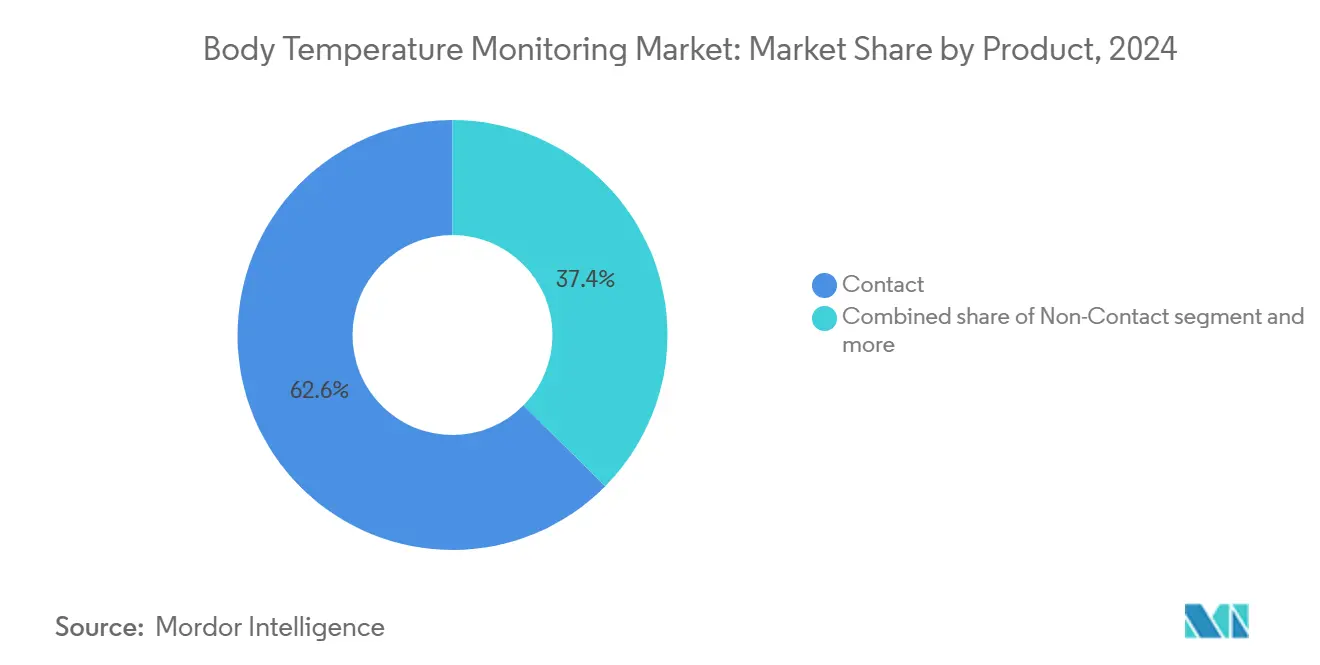
Note: Segment shares of all individual segments available upon report purchase
By Distribution Channel: Offline Procurement Still Dominates
Hospitals and large clinics rely on vetted distributors, generating 71.47% of 2024 revenue through the offline channel. Group purchasing organizations bundle thermometers with infusion pumps and monitors, favoring suppliers that offer clinical evidence and technical service contracts. Despite offline strength, the body temperature monitoring market witnesses rapid e-commerce uptake as small practices and households order direct from brand sites or marketplaces. Online sales surged during COVID-19 lockdowns and sustained momentum as consumers accepted self-care roles. Emerging direct-to-consumer brands leverage data dashboards, app-based coaching, and firmware updates to differentiate beyond price.
Distributors respond by digitizing catalogues and enabling click-and-collect models that preserve fulfillment control. Manufacturers experiment with subscription-based firmware analytics, creating recurring revenue on top of device shipments. Regulation continues to anchor a sizable offline base because many institutional buyers need calibration certificates and technical in-service training not yet matched by pure-play e-commerce storefronts.
By Application: Oral Cavity Remains Familiar but New Sites Surge
Oral thermometry captured 35.39% revenue in 2024 due to comfort, ease of cleaning, and proximity to core blood flow. Nevertheless, segments such as the temporal artery, wrist, and ear are expanding fastest. Wearables harness thin-film thermistors on the radial artery, continuous power management, and Bluetooth Low-Energy links to deliver clinical-grade trends without manual intervention. Research from the University of Washington demonstrated that a jewelry-style thermal earring beats smartwatch accuracy during rest, pointing to product diversification aimed at children and lifestyle users.
Rectal routes remain niche but indispensable for neonatal and post-anesthesia accuracy. The application spectrum thus spans single-use probe covers to AI-enabled biosensor patches, challenging suppliers to optimize calibration algorithms for different skin regions, sweat profiles, and motion artefacts. Rapid growth in fertility tracking platforms keeps wrist and skin-patch technologies in focus, supported by sensors that detect luteal-phase shifts as small as 0.1 °C.
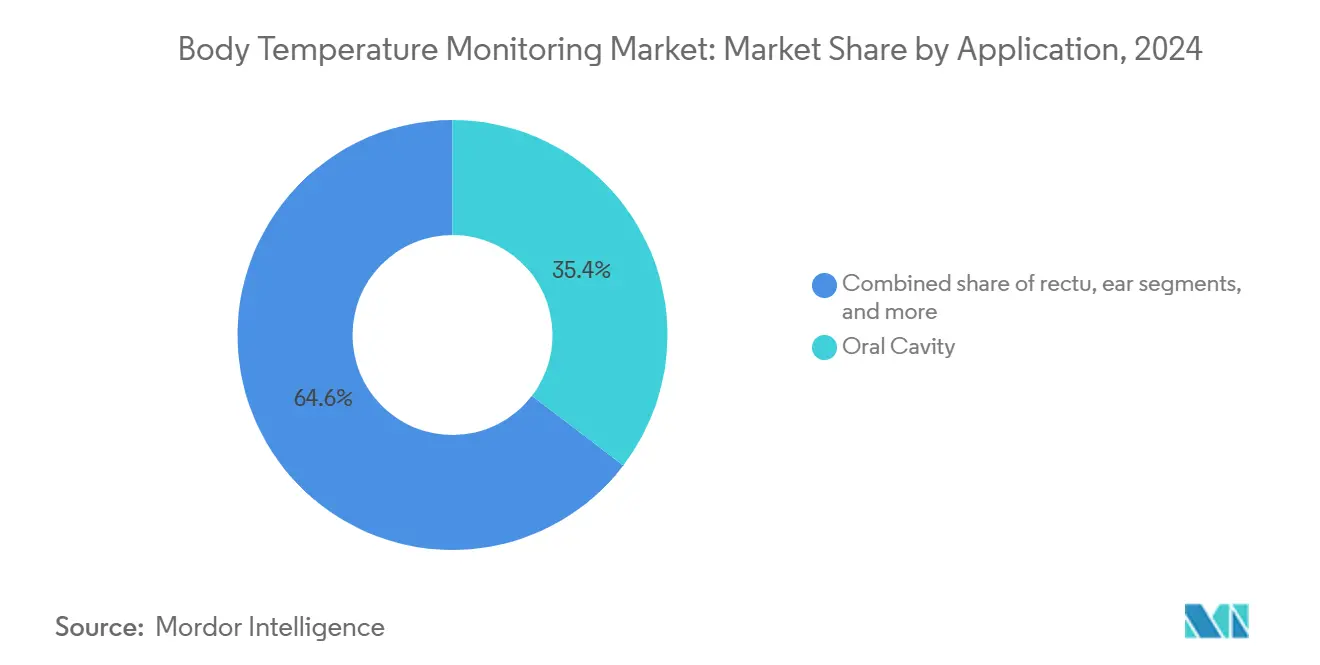
Note: Segment shares of all individual segments available upon report purchase
By End-User: Hospital Demand Evolving Toward Home Settings
Hospitals delivered 53.62% of global revenue in 2024, driven by bundled procurement of multi-parameter monitoring pods that incorporate temperature channels. Intensive care and emergency departments require minute-to-minute data resolution to guide antimicrobial stewardship and fluid therapy. Yet cost-pressure and value-based reimbursement steer convalescence to home environments where lower-cost wearables continue the continuity of care. The home-care segment is projected to record the fastest CAGR to 2030.
Device designs now prioritize intuitive placement, smartphone visualization, and automatic clinician alerts to suit lay caregivers. Pharmacies and telehealth portals supply starter kits with disposable patches and connected tablets. Schools, offices, and travel hubs represent emerging institutional end-users, embedding thermal imaging gates within broader access-control systems. The diversification strands revenue resilience across public health, consumer wellness, and professional care niches.
Geography Analysis
North America delivered the largest regional share at 41.58% in 2024, benefiting from mature reimbursement environments, hospital digitization programs, and early adoption of AI-enabled analytics. Integration partnerships between academic medical centers and OEMs fast-track pilots for multi-sensor platforms that combine temperature, blood oxygen, and motion data to predict deterioration events. The region’s stable 4.49% CAGR is underwritten by chronic disease prevalence and an expanding remote-care ecosystem that reimburses continuous monitoring hardware.
Asia-Pacific is the fastest-growing territory at 5.75% CAGR, linked to rising middle-class healthcare expectations and government stimulus for smart hospitals. China’s domestic manufacturers leverage scale and component verticalization to ship economical IR thermometers into export and domestic channels. Japan’s super-aged society drives home-care wearable uptake. India’s digital-health policy encourages remote vital sign kits in rural clinics, broadening the body temperature monitoring market footprint beyond urban tertiary centers. High smartphone penetration simplifies user onboarding for app-centric devices, while multinational brands form joint ventures to navigate heterogeneous regulatory schemes.
Europe maintains a robust trajectory with a 4.83% CAGR to 2030. Stringent data-protection rules catalyze on-device encryption and local gateway storage solutions, improving patient trust. Mercury device bans progress under the Minamata Convention alignment, triggering accelerated replacement cycles for digital and IR units. The Middle East and Africa, growing at 5.42% CAGR, channels oil revenues into tertiary healthcare clusters and public screening infrastructure. Mass events such as pilgrimages amplify demand for rapid, non-contact screening portals. South America progresses at 5.16% CAGR as public insurers upgrade basic equipment and private hospitals install connected monitoring suites. Currency swings and import tariffs continue to influence price positioning, rewarding value engineering and local assembly strategies.
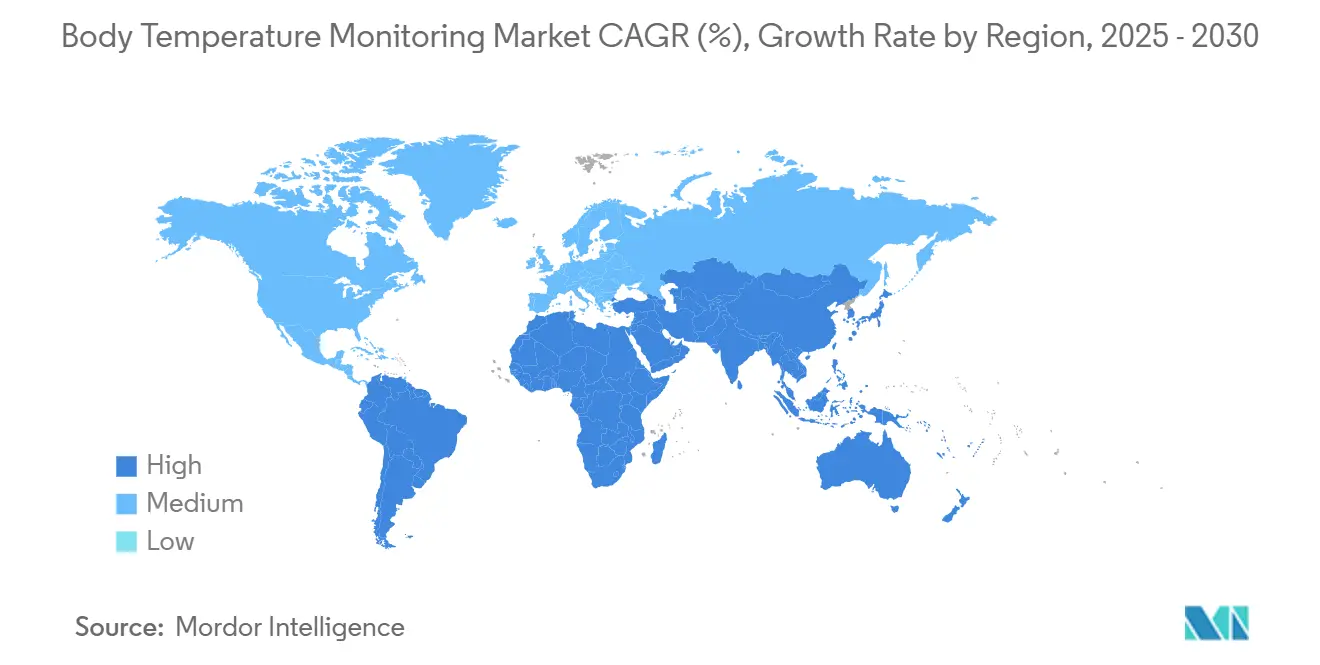
Competitive Landscape
More than 75 active manufacturers generate a moderately fragmented competitive field. Tier-one firms such as Philips, Omron, and Baxter provide broad device portfolios, global distribution, and strong regulatory dossiers. Mid-tier specialists like Blue Spark Technologies and Kinsa Health focus on connected consumer or patch solutions, differentiating through cloud analytics and epidemiological data dashboards.
Technology stacking defines competitive advantage. Vendors embed Bluetooth Low-Energy or Wi-Fi to push data into hospital EMRs or consumer wellness apps. AI layers deliver early-warning scores or fertility predictions, turning raw temperature into actionable insight. Component sourcing shifts toward CMOS-based microbolometers and high-density thermistor arrays, lowering the bill of materials while raising resolution. Service wrap-arounds, such as calibration-as-service and predictive maintenance, strengthen recurring revenue.
Regulatory agility becomes a second differentiator. FDA deregulation of low-risk digital sticks shortens release cycles, favoring agile firms. European IVDR compliance boosts entry barriers, encouraging outsourcing of technical documentation to speciality consultancies. Sustainability credentials emerge as a purchase criterion, with hospitals selecting mercury-free, low-plastic packaging to align with net-zero goals. Companies able to balance accuracy, cost, connectivity, and ESG attributes inch ahead in tenders.
Body Temperature Monitoring Industry Leaders
-
Baxter International
-
Helen of Troy Limited
-
Koninklijke Philips N.V.
-
Microlife Corporation
-
Omron Corporation
- *Disclaimer: Major Players sorted in no particular order
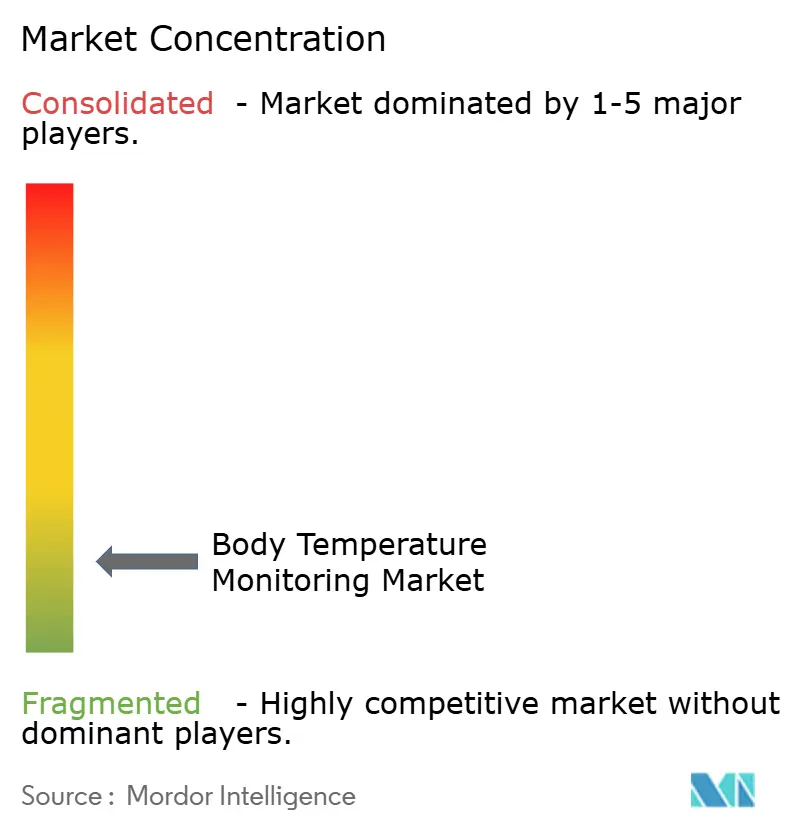
Recent Industry Developments
- June 2025: FDA granted 510(k) exemption for specified clinical electronic thermometers, trimming time-to-market for Class II devices.
- December 2024: Ultrahuman launched a subscription-free ovulation tracking mode on Ring AIR, using continuous skin temperature, resting heart rate, and HRV biomarkers.
- January 2024: Blue Spark Technologies introduced VitalTraq, a multi-parameter remote monitoring platform incorporating temperature, targeting hospital and post-acute care.
- August 2023: AION Biosystems secured FDA 510(k) clearance for iTempShield, a quarter-sized wearable enabling continuous temperature monitoring for inpatient and consumer use.
Research Methodology Framework and Report Scope
Market Definitions and Key Coverage
We define the global body temperature monitoring market as all electronic or sensor-based devices sold for measuring core or peripheral human body temperature in clinical, home-care, and wearable settings, including contact digital thermometers, infrared ear/temporal units, non-contact IR scanners, and continuous patch or wrist sensors. Emerging Bluetooth-enabled smart thermometers and hospital-grade probe systems are captured alongside their associated disposable covers and calibration accessories.
Scope exclusion: Industrial or laboratory thermocouples, data-logger probes, and process-control pyrometers are not counted.
Segmentation Overview
- By Product
- Contact
- Digital Thermometers
- Infrared Ear Thermometers
- Other Contact Products
- Non-Contact
- Non-contact Infrared Thermometers
- Thermal Scanners
- Wearable & Continuous-Monitoring Devices
- Contact
- By Distribution Channel
- Offline
- Online
- By Application
- Oral Cavity
- Rectum
- Ear
- Other Applications
- By End-User
- Hospitals
- Clinics
- Home-care Settings
- Other End-Users
- By Geography
- North America
- United States
- Canada
- Mexico
- Europe
- Germany
- United Kingdom
- France
- Italy
- Spain
- Rest of Europe
- Asia-Pacific
- China
- India
- Japan
- Australia
- South Korea
- Rest of Asia-Pacific
- Middle East and Africa
- GCC
- South Africa
- Rest of Middle East and Africa
- South America
- Brazil
- Argentina
- Rest of South America
- North America
Detailed Research Methodology and Data Validation
Primary Research
Structured interviews with clinicians in emergency rooms, biomedical engineers in procurement teams, home health nurses, and sensor OEM product managers across North America, Europe, and Asia helped us stress-test device rotation rates, procurement lead times, and regional ASP dispersion. Follow-up surveys with wearables users clarified replacement cycles that secondary sources under-reported.
Desk Research
Our analysts first mapped the demand universe through publicly available tier-1 datasets such as WHO communicable disease surveillance bulletins, CDC National Center for Health Statistics procedure volumes, Eurostat trade flows, UN Comtrade code 902519 shipment records, and device clearance files on the US FDA 510(k) portal. Trade association white papers from AAMI and the International Federation of Clinical Chemistry, peer-reviewed studies indexed on PubMed, and company 10-Ks added volume, pricing, and channel nuance.
Subscription resources, notably D&B Hoovers for supplier financials and Dow Jones Factiva for deal tracking, enriched competitive share splits and average selling price (ASP) checks. The sources listed illustrate our desk research spine; many additional datasets and journals were consulted during iterative validation.
Market-Sizing & Forecasting
A top-down construct begins with 2024 patient encounter counts and fever screening mandates, which are then linked to thermometer penetration ratios by care setting. Shipment and trade data reconstruct unit volumes, while median ASPs from distributor checks convert units to value. Bottom-up cross-checks sampled supplier revenues, hospital lot purchases, and online platform sales are layered to reconcile outliers. Key model drivers include infectious disease incidence, elective surgery rebounds, retail e-pharmacy share, pediatric and geriatric cohort growth, regulatory shifts toward mercury-free devices, and sensor miniaturization trends. Multivariate regression with ARIMA overlay forecasts the impact of these variables through 2030; scenario analysis tests pandemic re-surge and reimbursement shifts, and gaps in bottom-up input are bridged with weighted regional proxies.
Data Validation & Update Cycle
Before sign-off, results pass dual analyst peer review, variance triggers against historical series, and senior consultant audit. Models refresh annually, with mid-cycle updates if material events, such as major recalls, pandemic waves, or tariff changes, distort underlying assumptions. A fresh validation run is completed just prior to client delivery.
Why Mordor's Body Temperature Monitoring Baseline Numbers Inspire Confidence
Published estimates often diverge because firms pick different device sets, price bases, and refresh cadences.
Key gap drivers include: some studies omit wearable or continuous probes, others inflate totals by folding industrial sensors into healthcare demand, and a few roll forward pre-pandemic ASPs without post-COVID discounting corrections that our primary calls captured.
Benchmark comparison
| Market Size | Anonymized source | Primary gap driver |
|---|---|---|
| USD 1.78 billion | Mordor Intelligence | - |
| USD 1.66 billion | Global Consultancy A | Excludes wearable continuous devices and blends thermometer sales with broader monitoring systems, narrowing scope |
| USD 2.44 billion | Industry Association B | Relies on self-reported shipment surveys and single-region ASP averages, producing higher value |
| USD 4.28 billion | Regional Consultancy C | Aggregates industrial thermometry and uses mixed-year currency conversions without inflation alignment |
The comparison shows that Mordor's disciplined scope selection, dual-track modeling, and annual refresh provide a balanced, transparent baseline that decision-makers can trace back to clearly stated variables and repeatable steps.
Key Questions Answered in the Report
What is driving the rapid uptake of non-contact thermometers in clinical settings?
Stricter infection-control protocols established after COVID-19 have made touch-free infrared and thermal imaging devices a preferred choice for routine patient screening and visitor triage.
How are wearable sensors changing body-temperature monitoring practices?
Continuous skin-patches and smartwatches stream temperature data to cloud dashboards, enabling early detection of infection and allowing clinicians to track trends without manual spot checks.
Why are hospitals integrating temperature data into broader patient-monitoring platforms?
Connecting temperature with hemodynamic and respiratory metrics in a single interface supports earlier sepsis alerts and reduces the workload associated with independent device management.
What role do mercury-elimination initiatives play in product development?
Global bans on mercury instruments compel manufacturers to design low-cost digital alternatives that match the affordability of legacy glass thermometers while eliminating hazardous waste.
How is regulatory policy affecting innovation speed in this industry?
Recent FDA exemptions for certain low-risk electronic thermometers shorten approval timelines, encouraging companies to release software-enabled upgrades and iterate hardware more quickly.
What competitive strategy is most common among leading vendors today?
Established device makers are acquiring AI and IoT startups to bundle advanced analytics with traditional hardware, positioning themselves as end-to-end remote patient-monitoring providers.
Page last updated on:
